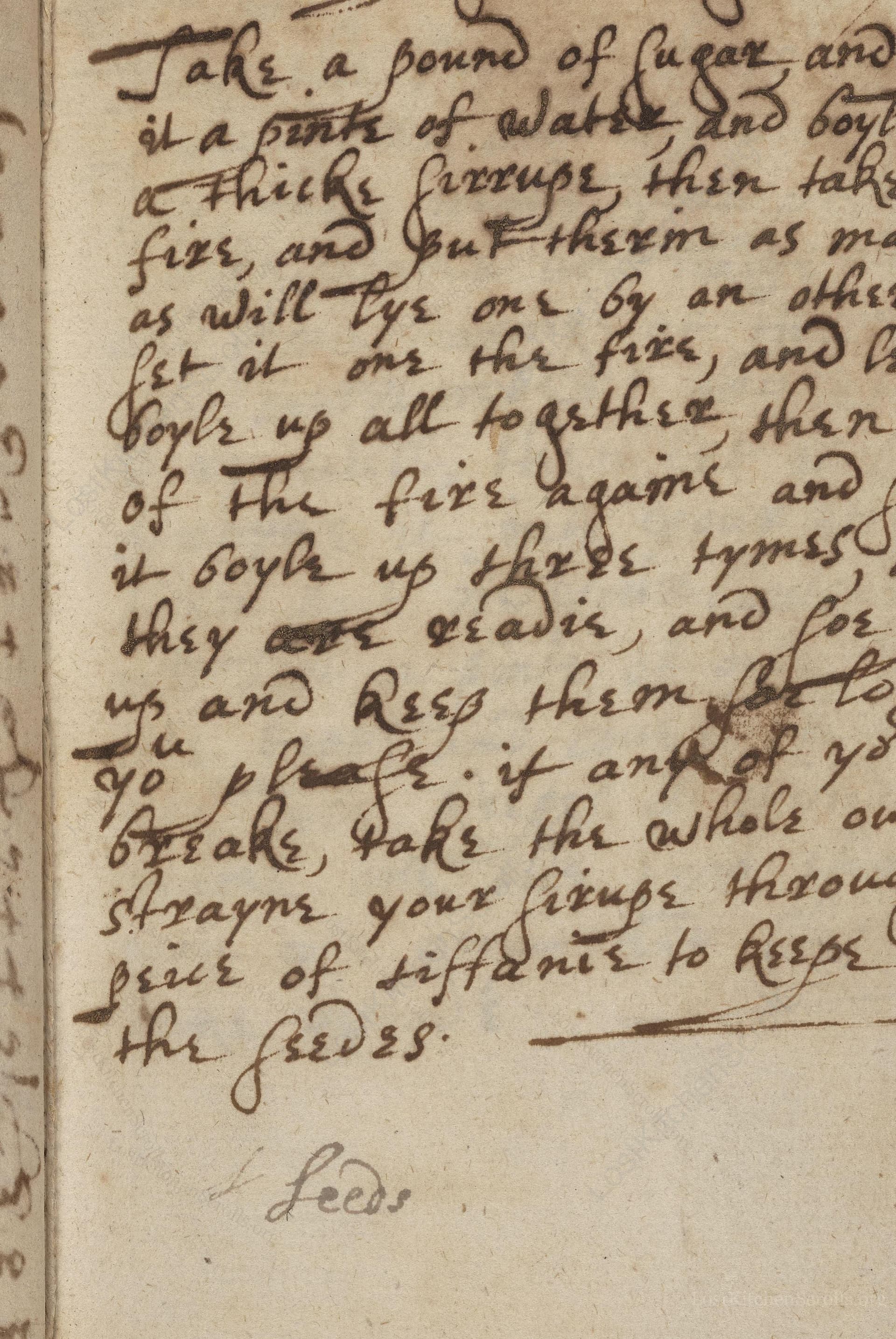To Preserve Raspes
From the treasured pages of Medicinal and cookery recipes of Mary Baumfylde
Written by Mary Baumfylde

To Preserve Raspes
"Take a pound of Sugar and put to it a pinte of Water and boyle it to a thicke Sirrupe, then take of the fixe, and put them as many Raspes as will tye one by an other, then set it on the fire, and let it boyle up all together, then take it of the fire againe and for let it boyle up three tymes, and then they are readie, and so put ym up and Keep them So long as you please. if any of yo Raspes breake, take the whole out, and strayne your Sirupe through a piece of tiffanie to Resps sacks the seeds."
Note on the Original Text
Early modern English recipes were written with sparse punctuation, inconsistent spelling, and little in the way of precise measurements or temperatures. Instructions were brief and assumed a level of kitchen knowledge from the reader. Words like 'boyle,' 'Sirrupe,' and 'tye one by an other' reflect period spellings and phrasing, while the method of boiling 'three tymes' is an example of iterative cooking—a gentle, repeated heating to preserve shape and vibrant color without destroying the fruit. Overall, the language is more suggestive than prescriptive, expecting cooks to exercise judgment and adapt to the ingredients and tools at hand.

Title
Medicinal and cookery recipes of Mary Baumfylde (1626)
You can also click the book image above to peruse the original tome
Writer
Mary Baumfylde
Era
1626
Publisher
Unknown
Background
A sumptuous journey into early 17th-century English cookery, this delightful volume offers a tantalizing glimpse into the recipes, flavors, and culinary secrets that once graced aristocratic tables. Prepare for a taste of history, presented with wit and wisdom!
Kindly made available by
Folger Shakespeare Library
This recipe comes from the early 17th century, reflecting the English tradition of fruit preserving at a time when sugar, though a luxury, was more widely available in aristocratic households. Mary Baumfylde, the author or compiler, was active around 1626—a time when such techniques were transferred among women in handwritten manuscripts. Preserving fruits like raspberries allowed seasonal flavors to be enjoyed throughout the year. Preserves were not only a treat but also an important way to prolong the shelf-life of fragile fruits before refrigeration or modern canning. Recipes like this one feature in family recipe books, often passed down through generations.

Historically, cooks would use a large brass or copper preserving pan set over a wood or coal fire. A long-handled wooden spoon or spatula was used for stirring and skimming, and a fine cloth such as tiffanie (a fine silk or cotton gauze) was employed for straining the syrup. Clean ceramic or glass jars—sometimes called pots—were used to store the preserves, sealed with leather, parchment, or waxed paper. The process required constant attention and steady hands to avoid burning the sugar or damaging the delicate fruit.
Prep Time
10 mins
Cook Time
30 mins
Servings
6
We've done our best to adapt this historical recipe for modern kitchens, but some details may still need refinement. We warmly welcome feedback from fellow cooks and culinary historians — your insights support the entire community!
Ingredients
- 2 1/4 cups granulated sugar
- 2 cups water
- 9–10 ounces fresh raspberries
Instructions
- To make this raspberry preserve, start by combining 2 1/4 cups of granulated sugar with 2 cups of water in a saucepan.
- Bring this mixture to a boil, creating a thick syrup—this will take about 10–15 minutes on medium heat, until the syrup is slightly thickened but still pourable.
- Skim off any foam that forms on the surface.
- Once your syrup is ready, gently add fresh raspberries (as many as will sit comfortably in a single layer in the syrup, about 9–10 ounces).
- Return the pot to the heat, bringing the mixture to a gentle boil.
- Allow it to boil up, then remove from the heat.
- Repeat this process of heating to a boil and removing three times in total.
- This helps set the fruit without breaking it apart.
- After the third boil, carefully transfer the whole preserved raspberries into sterilized jars and pour the syrup over them.
- If any raspberries break apart during cooking, you may remove them and strain the syrup through a fine mesh sieve or muslin cloth to separate seeds, creating a smooth raspberry sauce.
- Seal and store the preserves in a cool place—they will keep for several months.
Estimated Calories
120 per serving
Cooking Estimates
You will cook the syrup for about 15 minutes, then heat and cool the raspberries three times, which takes around 15 minutes more. Preparing your ingredients and sterilizing jars should take about 10 minutes. Each serving has about 120 calories, and this recipe makes 6 servings.
As noted above, we have made our best effort to translate and adapt this historical recipe for modern kitchens, taking into account ingredients nowadays, cooking techniques, measurements, and so on. However, historical recipes often contain assumptions that require interpretation.
We'd love for anyone to help improve these adaptations. Community contributions are highly welcome. If you have suggestions, corrections, or cooking tips based on your experience with this recipe, please share them below.
Join the Discussion
Rate This Recipe
Dietary Preference
Main Ingredients
Culinary Technique

Den Bockfisch In Einer Fleisch Suppen Zu Kochen
This recipe hails from a German manuscript cookbook compiled in 1696, a time whe...

Die Grieß Nudlen Zumachen
This recipe comes from a rather mysterious manuscript cookbook, penned anonymous...

Ein Boudain
This recipe comes from an anonymous German-language manuscript cookbook from 169...

Ein Gesaltzen Citroni
This recipe, dating from 1696, comes from an extensive anonymous German cookbook...
Browse our complete collection of time-honored recipes



